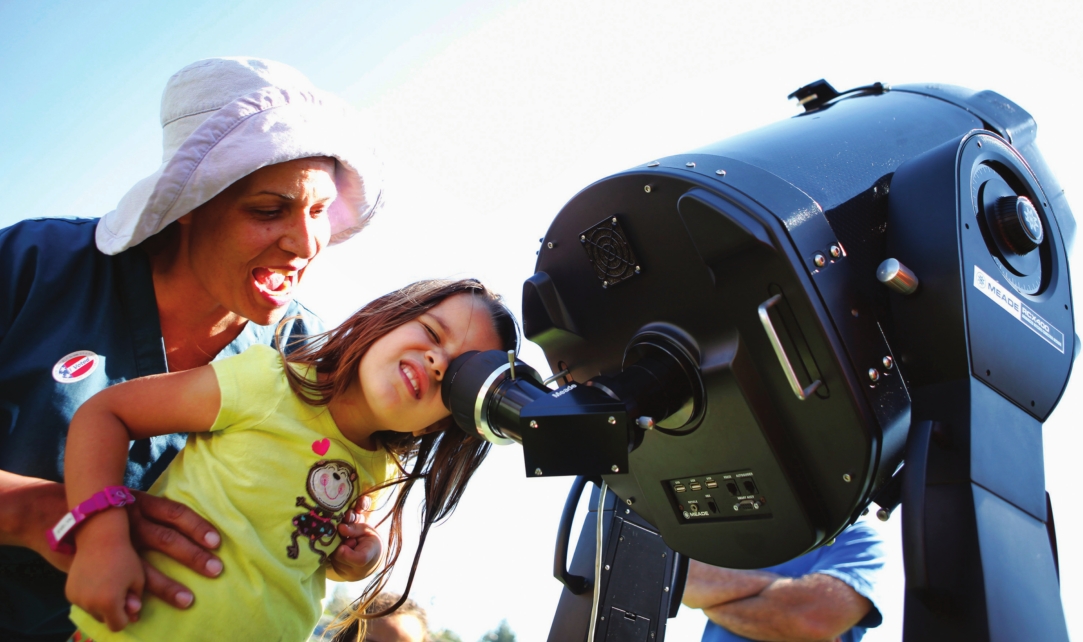
The night sky fascinates children and parents
When Anne Gregurich of Springfield was 13 years old, she decided to build her own telescope after watching a Nova documentary. “I made it out of paper towel tubes and magnifying glasses,” said the now 16-year-old, a junior at Springfield High School. “I went outside and saw the moon.
“Everyone has some kind of interest at some point,” continued Anne, who would go stand in the driveway every night. She taught herself astronomy. She would write essays and do problems. “I wanted a better understanding,” she said. “It makes it a more enriching experience.”
She enjoys spending time with her dad, Carl, who works at Memorial Medical Center. “I’m her assistant,” her dad said, laughing, adding the two of them are very close. He never had an interest in astronomy. “Once you start learning, it’s hard not to pick up a bit of interest.”
“I got my dad into it,” said Anne. He had to get involved. She needed someone to set up her telescope. “I taught him stuff.”
It doesn’t cost anything to get started.
“I had just as much fun standing in the driveway with or without a pair of binoculars,” she said.
Her dad knows more about telescopes than she does. He researched telescopes before purchasing one and would help her carry it.
“You want to buy from a legitimate dealer who specializes in astronomical equipment,” said her dad. “Nothing kills a hobby faster than a cheap telescope.” Anne owns a six-inch computer-assisted reflector table top telescope.
“It’s been very memorable,” said her dad, adding this has been a bonding experience. “I’m glad I’ve gotten into it.” He admits he’s not as thoroughly immersed in it as his daughter. “I’ll look up and see something she taught me about,” he said.
Anne plans to pursue this as a hobby for the rest of her life. “It’s something I’ll always want to do,” she said. “There’s something about seeing space with your own eyes.”
They belong to the Sangamon Astronomical Society, which was formed around 1953 by a group of astronomy buffs who got together after World War II. One of the founders, Don Jardine, is still involved. The club has about 30 members and meets monthly. Club members would like to see more young people get involved.
“Kids are fascinated by it,” said club president Ray Watt. “They ask lots of questions.” He hears a lot of oohs and aahs when kids look through the telescopes at a public event. “The kids get a huge kick out of looking at things that are familiar to them like the moon, Jupiter and the rings of Saturn,” he said.
“Kids’ eyes just get huge and they get this big smile,” added Watt. “They thank you several times. It’s so neat.” Parents and kids have a great time. Part of the club’s mission statement is spreading interest in astronomy. “It’s nice to see people get involved,” said Watt, who recommends coming out to one of the club’s public events.
He loves seeing families. “Children and parents have a natural affinity for astronomy,” said Watt. “It’s time parents and children can share. The kids will tell us about the objects they’re looking at. Parents are stunned that their children know all this. It’s a bridge builder.”
For families who just want to have fun for one night, Dr. John Martin, associate professor of astronomyphysics at the University of Illinois Springfield, suggests coming to a Friday night star party at the UIS observatory. There are eight in the fall and four in the spring. Since 1980, more than 120,000 people have come out.
He loves interacting with children.
“Young eyes see a lot better and can see things older eyes can’t see,” said Martin, who caters his talk to kids. In the dome, he always has kids look first and then describe what they see in the telescope. “Kids aren’t shy about saying what they see.”
Martin would love to see children take away a greater appreciation for math and science. “It opens their eyes to ideas that are useful to them and that they can use in daily life,” he said. “It makes the world around them a better place.”
He calls astronomy a gateway science. “We share a common humanity,” said Martin. “We all talk about our experiences with the night sky. It’s common for all human beings. The night sky hasn’t changed in 20,000 to 30,000 years. We don’t all experience it the same way.”
There are a lot of ways to get your kids involved in astronomy. Martin suggests reading magazines like Sky & Telescope and Astronomy or attending one of the Sangamon Astronomical Society’s public events. There are also crowdsourcing sites like Galaxy Zoo that allows the public to help with large-scale research projects.
“You don’t need equipment to see the night sky,” added Martin. “All you have to do on a clear night is pick a direction and drive 20 minutes and look up.”
Roberta Codemo is a frequent contributor to CC Parent. She remembers once driving in a snowstorm on the first day of spring trying to catch a glimpse of Halley’s Comet. She can be reached at rcodemo@hotmail.com.